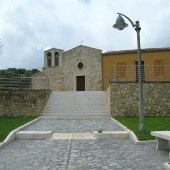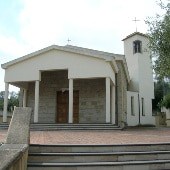Pompu

OUR LADY OF MONTSERRAT
There is no unquestionable evidence such as to suggest the dating of this parish church located in Pompu (OR). The 18th-century sources report about a collapsing church subject to restoration works; on that occasion, the tabernacle and the baptismal font were realized. The walls were realized with a mixed technique through the apposition of yellow pebbles of sandstone.
More...
The chromatic differences highlight the stone textures on the upper part of the walls, testifying at least three different development stages of the nave. Similarly, the hexagonal window in the center of the façade is surrounded by a texture which seems to be inconsistent with the rest of the wall. These details suggest the pre-existence of a circular opening and a small bell-gable on the top of the old monument, that was later replaced by a massive double-gable tower on the left of the façade. Until the last decades of the 20th century, next to the church there was a cemetery, inaugurated two centuries earlier.
In 1626, Reverend Giovanni Antioco Pilloni, priest of the towns of Morgongiori and Pompu, commissioned the Neapolitan painter Giuseppe Valona (Gallona) to paint Our Lady of Montserrat, for 33 écus. Enclosed by a carved golden frame, the painting showed the Virgin Mary, baby Jesus, and an angel with a saw; however, the fate of such painting is unknown.

SAint SEBASTIAN parish church
Example of 20th century rationalist architecture, this church maintains the dedication of an earlier temple, located further below, which collapsed in 1865. Devotion had the worshippers saving the simulacrum of St. Sebastian to place it in the parish church of St. Mary. Following the construction of a new church, the definitive dedication bears the names of the martyr soldier and Saint Demetrius.
More...
The building might reopen the debate on contemporary architecture’s ambitions for religious buildings; the designer adopted a conservative style whilst maintaining some historicized features. A narthex decorated with an architrave leads to the main body of the church, sided by a number of chapels; next to the entrance, an old stone baptismal font is placed.
Inside the church, three statues are located: a 17th-century Madonna with her child and two 18th-century statues of a young St. Sebastian and St. George riding his horse. The view from the square is characterized by the juxtaposition of the church, covered with yellow sandstone blocks, and the bell tower, a postmodern compositional experiment. Close to Aldo Rossi’ s architectural poetics, the portico with columns and the bell tower, marked by unusual and repeated angular windows, denote ambitious purist inflections.

POLO MUSEALE MASULLAS
More...
...allodiale, con la prerogativa di successione anche per linea femminile e l’esercizio in sede giurisdizionale del mero et mixto imperio, che concede il potere di amministrare la giustizia sia nel civile che nel criminale.In ogni curatoria o baronia appartenente al Marchesato vengono istituite le curie baronali e sono nominati i diversi giudici. Le cause sono spesso di natura fiscale, altre riguardano fatti criminali. L’amministrazione della giustizia feudale risulta però confusa e arbitraria: curie senza archivi ordinati, personale dotato di scarsa preparazione, corruzione e connivenza con i bandos organizzati, carceri ridotte al solo ceppo e in locali molto ristretti.
Masullas, oltre alle milizie, ospita in questi locali la curia baronale con le relative carceri.
Nel 1564, per fermare lo strapotere dei baroni nell’amministrazione della giustizia, il sovrano spagnolo Filippo II istituisce il tribunale della Reale Udienza, che giudica in appello sulle cause tra vassalli, villaggi e feudatari.
A farne parte sono letrados esperti in materie giuridiche. L’incarico più importante all’interno della magistratura è il Reggente della Reale Cancelleria, coadiuvato da altri giudici, come l’Avvocato Fiscale.
In seguito alla richiesta degli Stamenti nel Parlamento, nel 1651 viene istituita la Sala Criminale della Reale Udienza, con competenza sulle cause di natura penale.
Il ruolo che la Reale Udienza assume nel corso del periodo spagnolo non è meramente giuridico, poiché essa col tempo diventa un organo consiliare che supporta i viceré nel governo del Regno.
Info
Ex Convento dei Cappuccini
Via Cappuccini, 57
09090 MASULLAS (OR)
Sardegna
Italia
coopilchiostro@tiscali.it
Collegamenti
- Atti amministrativi
- Termini e condizioni
- Privacy Policy
- Cookie Policy
- CEAS
Newsletter
Iscriviti alla nostra newsletter per rimanere aggiornato sugli eventi del polo museale del comune di Masullas
SOSTEGNO PUBBLICO
PROGETTO NEOLITHIC PARK 3D
CUP: E78D17000220007
Bando CultureLab “Sostegno finanziario alle imprese del settore culturale e creativo per lo sviluppo di progetti culturali innovativi”




